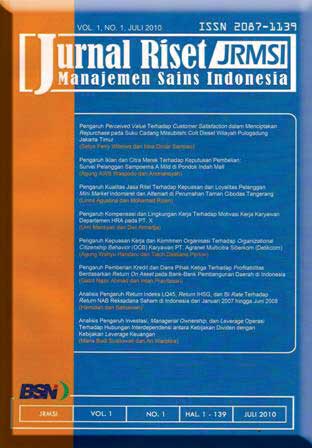PERCEIVED SERVICE QUALITY DAN INTENTION MAHASISWA DI SURABAYA: STUDI EMPIRIS PADA APLIKASI MOBILE DENGAN LAYANAN FREEMIUM
DOI:
https://doi.org/10.21009/JRMSI.011.1.04Keywords:
service quality, usage intention, purchase intention, freemiumAbstract
Penelitian ini bertujuan untuk menganalisis hubungan antara service quality dan intention pada penggunaan aplikasi mobile yang memiliki layanan freemium oleh mahasiswa di Surabaya. Penelitian ini menggunakan teknik purposive sampling terhadap 149 mahasiswa. Kriteria sampel adalah mahasiswa yang menggunakan aplikasi dengan layanan freemium di smartphone yang mereka miliki. Penelitian ini menggunakan alat analisis statistic partial least square dengan software SMART PLS. Hasil penelitian menunjukkan bahwa: (1) perceived service quality berpengaruh positif signifkan terhadap usage intention dan purchase intention (2) assurance, empathy, reliability dan responsiveness berpengaruh positif namun hanya responsiveness yang pengaruhnya signifikan terhadap usage intention (3) assurance, empathy, reliability dan responsiveness berpengaruh positif namun hanya assurance yang pengaruhnya signifikan terhadap purchase intention (4) usage intention berpengaruh positif signifikan terhadap purchase intention.
References
APJII. (2019). Infografis Penetrasi & Perilaku Pengguna Internet Indonesia.
Brockmann, T., Stieglitz, S., & Cvetkovic, A. (2015). Prevalent Business Models for the Apple App Store. WIRTSCHAFTSINFORMATIK PROCEEDINGS 2015. Retrieved from https://aisel.aisnet.org/wi2015/81/
Chin, W. W. (1998). The Partial Least Squares Approach to Structural Equation Modeling. Advances in Hospitality and Leisure.
Cohen, J. (2013). Statistical Power Analysis for the Behavioral Sciences (2nd ed.). Burlington: Elsevier Science.
Daily Social. (2018). Laporan DailySocial: Survei Layanan Streaming Musik 2018. Retrieved from Daily Social website: https://dailysocial.id/post/laporan-dailysocial-survei-layanan-streaming-musik-2018/
Falk, R. F., & Miller, N. B. (1992). A Primer for Soft Modeling. University of Akron Press.
Gefen, D. (2002). Customer Loyalty in E-Commerce. Journal of the Association for Information Systems, 3. Retrieved from https://pdfs.semanticscholar.org/00f2/f77fe6480f66c2982010a091e8c76c61b7ff.pdf
Hair, J. F., Ringle, C. M., Hult, G. T. M., & Sarstedt, M. (2014). A Primer on Partial Least Squares Structural Equation Modeling. California: SAGE Publications, Inc.
Hamari, J., Hanner, N., & Koivisto, J. (2017). Service quality explains why people use freemium services but not if they go premium: An empirical study in free-to-play games. International Journal of Information Management, 37(1), 1449–1459. https://doi.org/10.1016/j.ijinfomgt.2016.09.004
Hamari, J., & Järvinen, A. (2011). Building Customer Relationship through Game Mechanics in Social Games. In Business, Technological, and Social Dimensions of Computer Games (pp. 348–365). https://doi.org/10.4018/978-1-60960-567-4.ch021
Hamari, J., & Keronen, L. (2017). Why do people play games? A meta-analysis. International Journal of Information Management, 37(3), 125–141. https://doi.org/10.1016/j.ijinfomgt.2017.01.006
Hamari, J., & Lehdonvirta, V. (2010). Game design as marketing: How game mechanics create demand for virtual goods. International Journal of Business Science and Applied Management, 5(1), 15–29. Retrieved from https://www.researchgate.net/publication/26644787_Game_design_as_marketing_How_game_mechanics_create_demand_for_virtual_goods
Hanner, N., & Zarnekow, R. (2015). Purchasing Behavior in Free to Play Games: Concepts and Empirical Validation. 2015 48th Hawaii International Conference on System Sciences, 3326–3335. https://doi.org/10.1109/HICSS.2015.401
Holin Lin, & Sun, C.-T. (2011). Cash Trade in Free-to-Play Online Games. Games and Culture, 6(3), 270–287. https://doi.org/10.1177/1555412010364981
Kulas, J. T. (2008). SPSS Essentials: Managing and Analyzing Social Sciences Data. New Jersey: John Wiley & Sons.
Kumar, V. (2014). Making “Freemium” Work. Retrieved from Harvard Business Review website: https://hbr.org/2014/05/making-freemium-work
Lewis, C., Whitehead, J., & Wardrip-Fruin, N. (2010). What went wrong. Proceedings of the Fifth International Conference on the Foundations of Digital Games - FDG ’10, 108–115. https://doi.org/10.1145/1822348.1822363
Lin, H., & Sun, C.-T. (2007). Cash Trade Within the Magic Circle: Free-to-Play Game Challenges and Massively Multiplayer Online Game Player Responses. Proceedings of the 2007 DiGRA International Conference: Situated Play.
Lin, T.-C., Hsu, J. S.-C., & Chen, H.-C. (2013). Customer Willingness to pay for online music: The role of free mentality. Journal of Electronic Commerce Research, 14(4), 315–333.
Liu, C. Z., Au, Y. A., & Choi, H. S. (2015). Effects of Freemium Strategy in the Mobile App Market: An Empirical Study of Google Play. Journal of Management Information Systems, 31(3), 326–354. https://doi.org/https://www.researchgate.net/deref/http%3A%2F%2Fdx.doi.org%2F10.1080%2F07421222.2014.995564
Mäntymäki, M., & Salo, J. (2013). Purchasing behavior in social virtual worlds: An examination of Habbo Hotel. International Journal of Information Management, 33(2), 282–290. https://doi.org/10.1016/j.ijinfomgt.2012.12.002
Oestreicher-Singer, G., & Zalmanson, L. (2013). Content or Community? A Digital Business Strategy for Content Providers in the Social Age. MIS Quarterly, 37(2), 591–616. https://doi.org/10.25300/MISQ/2013/37.2.12
Rajaguru, R. (2016). Role of value for money and service quality on behavioural intention: A study of full service and low cost airlines. Journal of Air Transport Management, 53, 114–122. https://doi.org/10.1016/j.jairtraman.2016.02.008
Septiyani, A. (2019). Gokil! Orang Ini Habiskan Uang 1,2 Milyar Demi Item Langka Ragnarok M. Retrieved from Kompas Gramedia website: https://games.grid.id/read/151638531/gokil-orang-ini-habiskan-uang-12-milyar-demi-item-langka-ragnarok-m?page=all
Tsang, K. K. (2012). The use of midpoint on Likert Scale: The implication for educational research. Hong Kong Teachers’ Centre Journal, 11, 121–130.
Zeithaml, V. A., Berry, L. L., & Parasuraman, A. (1996). The Behavioral Consequences of Service Quality. Journal of Marketing, 60(2), 31. https://doi.org/10.2307/1251929
Zeithaml, V. A., Parasuraman, A. P., & Malhotra, A. (2000). A Conceptual Framework for Understanding E-Service Quality: Implications for Future Research and Managerial Practice. Marketing Science Institute Working Paper Report No. 00-115.
Downloads
Published
How to Cite
Issue
Section
License

Articles in Jurnal Riset Manajemen Sains Indonesia are Open Access articles published under the Creative Commons CC BY-NC-SA License. This license permits use, distribution and reproduction in any medium for non-commercial purposes only, provided the original work and source is properly cited. Any derivative of the original must be distributed under the same license as the original.











